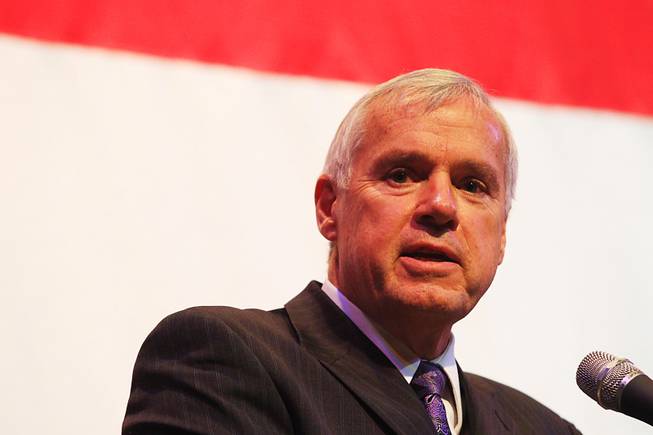
Chancellor Dan Klaich speaks during a town hall style meeting about education Tuesday, Nov. 29, 2011 on the CSN Cheyenne campus.
Thursday, Jan. 12, 2012 | 2 a.m.
Related Stories
One front in Nevada’s ongoing civil war over the next year will be how the state divides money among its universities and community colleges.
UNLV and the College of Southern Nevada are shortchanged by a combined $55 million every two years, a Southern Nevada lawmaker said Wednesday at the first meeting of a committee to discuss allocation of higher ed dollars.
Sen. John Lee, D-North Las Vegas, said because unequal allocation of state funds Southern Nevada college students subsidize students at the state’s northern and rural campuses.
UNLV students, for example, pay 48 percent of all tuition dollars in the state, but the campus only receives 34 percent of state funding.
UNR students contribute 27 percent of the state’s tuition and get the same percentage of the state higher education budget as UNLV, he said.
Officials from both Southern and Northern Nevada acknowledged the formula must change, with many agreeing that tuition should stay at the institutions where it’s collected rather than be pooled across the state. The 2011 Legislature approved $700 million a year for higher education, with about $470 million of that in state general funds and the rest in tuition.
But instead of framing it in north-south terms, members of the interim study committee avoided talking about how a new funding formula would affect one institution or another. They said the new way of allocating state resources should look at performance measures, like graduation rates.
“It’s clear to me that the Legislature and governor (Brian Sandoval) are interested in performance,” said Nevada System of Higher Education Chancellor Dan Klaich. “Our purpose is not just enrolling students and taking their money, but graduating them with skills.”
Klaich said it’s not clear whether the system is unfair, but he said Wednesday the current formula should be thrown out.
“Our current funding formula lacks credibility in the state, whether it’s a real or a perceived unfairness,” Klaich said.
He also noted it was too complicated to understand.
“We need to set it aside, start from square one to construct something that’s fair and equitable,” he said.
Klaich proposed a new funding formula, which would allow institutions to keep more of their tuition dollars, particularly from out-of-state and international students. That, he said, would give the institutions an incentive to improve.
It’s unclear how that formula would play out, Klaich said. The measures to evaluate the institutions, like graduation rates and degrees, are still fluid. The state plans to hire a consultant to develop the formula.
The new formula on how to divvy up money, which is supposed to be settled by the Committee to Study the Funding of Higher Education, is expected to be used by Sandoval to build the state’s budget for the next two years, beginning in 2013.
The members of the interim committee — 12 voting members and four nonvoting members — are evenly split between north and south, and most avoided the north-south tension.
Gregory Mosier, dean of the University of Nevada, Reno business school, warned that “this should not be a zero-sum game fought between institutions in the state.”
But Lee’s remarks to start the meeting ensured that one simmering question throughout the process will be whether the south gets its share.
“The biased funding formula has left historical inequities ... of over $20 million for CSN and $25 million for UNLV,” Lee said. “Of all state institutions, CSN receives the least amount of funding but serves the largest number of students. Both CSN and UNLV provide the most opportunity for our state’s most vulnerable communities that are disproportionally located in the south.”
Southern Nevadans have complained that the state subsidizes the north and rural counties in everything from K-12 schools — Clark County gets the lowest per-pupil funding in the state — to social services and road projects. Almost three-quarters of the state’s population lives in Clark County, and the Strip is the major source of state tax revenue.
But Southern Nevadans have had a difficult time quantifying the disparity and allowed Northern Nevada lawmakers in key positions — former Senate Majority Leader Bill Raggio, R-Reno, and former Assembly Speaker Joe Dini, D-Yerington — to discount such grumbling or pass it off to yet another study.
The Committee to Study the Funding of Higher Education, the result of a bill passed during the 2011 Legislature, is tasked with changing the formula.
“I don’t think this (committee) is about north-south,” said Heidi Gansert, Sandoval’s chief of staff and a former assemblywoman from Reno. “It’s about coming up with an equitable formula for funding higher education.”
Sen. Ben Kieckhefer, R-Reno, another member of the committee, said the formula would almost certainly send more money to Southern Nevada institutions.
“I don’t think it’s possible to redo the formula and have more money going to Northern Nevada,” he said.
He said he believed a fair formula would be welcomed by the colleges and universities.
“If they lose a little money now ... but can be entrepreneurial, are encouraged to attract and retain students and keep that money, they’re not afraid of taking on responsibility,” he said.

Join the Discussion:
Check this out for a full explanation of our conversion to the LiveFyre commenting system and instructions on how to sign up for an account.
Full comments policy